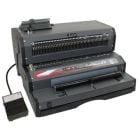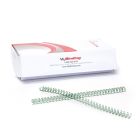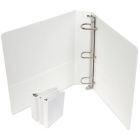Dos and Don'ts of Effective Presentations
Effective communication begins with an effective presentation. From the words, to the graphics, to the materials that you use for the presentation - it all works together to create the most effective communication vehicle possible. Be it the overall finishing, such as the binding, folding or lamination you select, or the content contained inside, everything communicates and you should use all of the tools in your arsenal to communicate effectively. To that end, the following are some Dos and Don'ts to keep in mind in the effective creation of a presentation.
The Do's:
1)Know Your Stuff:
This may seem quite obvious, but researching and developing a complete understanding of the presentation subject is the foundation for any effective presentation. Do your homework and it will pay off in the end
2)Stick To Your Story:
Your presentation should have one purpose in mind and stick to that purpose from beginning to end. Ask yourself these questions at the beginning of any presentation development process; Am I selling something? Am I persuading someone? Am I educating someone? Or simply entertaining my audience? Create your story and don't get off track.
3)"Remember that "Books" are Judged By Their Covers:
You may have been admonished to "Never judge a book by its cover," but when creating an effective presentation, you should adhere to a different adage: "Don't leave anything to chance." A professional-looking presentation can push your audience toward a positive decision the moment they see it. Laminated covers and well-bound presentations are the best way to ensure your audience will be excited to open up and see what's next!
4)Have a Beginning, Middle, (Summary) and End:
It may seem like Theme-Paper Writing 101, but "the basics" are "the basics" for a reason - they work! People think, and perceive information in a similar way. It is natural for them to follow this well-known pattern, starting with an Opening that sets the stage for the rest of the presentation, a Body in which the overall subject is presented, a Summary to touch on major points, and a Closing, usually with some "call to action" for your audience.
5)Put it in a Picture:
Studies have shown that people learn more quickly and retain information better when the subject is reinforced with visuals. Your audience will get your point immediately with the use of the right visual, making it literally "worth a thousand words." Clear and simple graphics or pictures used for full-effect are the best way to connect with your audience. The way these pictures are presented is equally as important as the picture itself. Consider lamination to properly preserve and highlight this important aspect of your presentation.
The Don'ts:
1)Avoid Saying Too Much:
While you may be wildly excited about your subject, don't assume your audience has hours of time to devote to reading and absorbing the information. Make your points clearly and concisely and move on. There is no reason to use 5 words when one or two are just as effective in helping you tell your story.
2)Don't Forget the Devil in The Details:
From the presentation cover, to it's binding to the first and last sentences, details count. A professional overall appearance draws your readers in to the presentation in a way that little else can. After this initial response, however, everything else in the presentation must deliver on this promise of quality. Check your spelling, grammar and sentence structure over and over again, and not just by using your computer's spell-check or grammar-check program. Read the presentation out loud to make sure you are saying exactly what you want to say - from beginning to end.
3)Stop Using The Wrong Images:
There are many correct ways to use a visual in a presentation, and just as many incorrect ones. Too small, too blurry, overly-complicated, or just plain distracting images will have the opposite effect on your audience than you wish to create. Good, clear and effective visuals are the best way to go - and highlighting them with the proper framing, laminating or other enhancement only serves to make your presentation stronger.
4)Avoid Getting it done on the "Cheap:"
Saving on overhead when preparing your presentation may seem like a good idea, but think again! Cutting corners by not creating a professional-looking presentation, including everything from the cutting, folding, binding and cover creation, can cause you to lose big in the long run. If you cut corners on your presentation or proposal, you may cut corners on the project or product you are proposing. Do it right the first time and get the chance to do it again - and again!
5)Don't Forget the Call to Action!
Telling the story about your product or service is great - but forgetting to tell the audience what you would like them to do with this information is a big mistake! Don't miss the opportunity to end your presentation with a simple, specific call to action, usually tied to a deadline for feedback of some kind. This will give your "story" the happy ending you are looking for!









